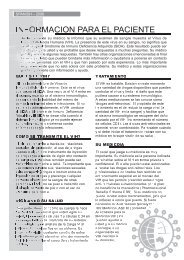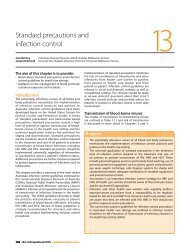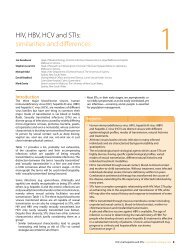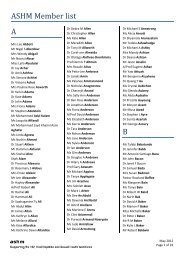B Positive – all you wanted to know about - ASHM
B Positive – all you wanted to know about - ASHM
B Positive – all you wanted to know about - ASHM
You also want an ePaper? Increase the reach of your titles
YUMPU automatically turns print PDFs into web optimized ePapers that Google loves.
now largely superseded lamivudine as the firstline<br />
therapy of choice for the treatment of cHb<br />
in australia.<br />
entecavir can be used in patients who have<br />
developed resistance <strong>to</strong> lamivudine. Higher<br />
doses of 1.0 mg daily are required <strong>to</strong> suppress<br />
lamivudine-resistant HbV. despite higher<br />
doses, antiviral activity remains lower than that<br />
seen with wild-type HbV. despite its improved<br />
potency, patients with lamivudine-resistant<br />
mutants are more likely <strong>to</strong> develop resistance <strong>to</strong><br />
entecavir (17% after four years of treatment). 14<br />
entecavir is thus not the best choice for patients<br />
with lamivudine resistance, who should ide<strong>all</strong>y<br />
be treated with adefovir. 1<br />
Adefovir<br />
adefovir, an acyclic phosphorate nucleoside<br />
analogue, is an effective antiviral agent. the<br />
control of viral replication and improved<br />
biochemical, his<strong>to</strong>logical and clinical outcomes<br />
have been demonstrated. adefovir is or<strong>all</strong>y<br />
active and well <strong>to</strong>lerated at the 10 mg daily<br />
dose recommended for use in HbV infection.<br />
it may be taken without regard <strong>to</strong> food. the<br />
potency of adefovir at this dose is less than that<br />
of other available antivirals. Higher doses, while<br />
more effective, cannot be used because of<br />
nephro<strong>to</strong>xicity. the renal function at the 10mg<br />
dose does, however, need <strong>to</strong> be moni<strong>to</strong>red, as<br />
renal <strong>to</strong>xicity can occur with long-term use. 1<br />
While in the us adefovir is used in the first<br />
line setting, currently the Pbs requires that<br />
adefovir be limited in the setting of lamivudine<br />
resistance. in this setting, adefovir is added<br />
<strong>to</strong> lamivudine therapy for the first three<br />
months in patients with compensated disease,<br />
and for the first 12 months in patients with<br />
decompensated disease; adefovir is then<br />
used on its own, as monotherapy. the rate of<br />
resistance <strong>to</strong> adefovir in the first line setting is<br />
much lower than lamivudine (0% after one year<br />
of treatment, 1% after three years and 30% after<br />
five years of treatment). 15 unfortunately, the<br />
rates of resistance <strong>to</strong> adefovir are much higher<br />
in patients already resistant <strong>to</strong> lamivudine.<br />
Long term combination therapy with adefovir<br />
and lamivudine in patients with lamivudine<br />
resistance is associated with much lower rates<br />
of resistance. 1 although the Pbs does not<br />
currently fund this approach, combination<br />
lamivudine/adefovir in this setting is likely <strong>to</strong><br />
gain approval in the near future.<br />
Future therapies (not yet approved in<br />
Australia)<br />
emtricitabine, tenofovir and telbivudine are<br />
agents not yet available in australia, but with<br />
<strong>know</strong>n efficacy against HbV replication. it is<br />
likely that some or <strong>all</strong> will be available as Pbs<br />
subsidised therapy in australia in the near<br />
future, depending on their efficacy, <strong>to</strong>lerability<br />
and rates of resistance. overseas data suggest<br />
that tenofovir may have the most beneficial<br />
profile of these three new agents. 1<br />
tenofovir, like adefovir, is an acyclic adenine<br />
nucleotide, with potent activity against HbV.<br />
it is currently in use for the treatment of HiV<br />
infection. as a result of its potency, tenofovir<br />
is particularly effective in patients with<br />
lamivudine-resistant cHb, and is likely <strong>to</strong> have<br />
an important role in treatment-naïve patients<br />
with HbV infection. 1<br />
emtricitabine, like lamivudine, is an Lnucleoside<br />
agent with a level of potency and<br />
resistance similar <strong>to</strong> lamivudine. telbivudine is<br />
also an L-nucleoside agent that may be more<br />
potent than lamivudine, with rates of resistance<br />
that are lower than those of lamivudine, but<br />
substanti<strong>all</strong>y higher than those of entecavir and<br />
adefovir. 1 both emtricitabine and telbivudine<br />
are ineffective in the setting of a lamivudineresistant<br />
virus. these drugs may find their place<br />
in combination therapy regimes, which are<br />
under investigation at the present time.<br />
Moni<strong>to</strong>ring patients on antiviral<br />
therapy<br />
Patients should be moni<strong>to</strong>red regularly while<br />
on therapy <strong>to</strong> document their response <strong>to</strong><br />
antiviral therapy, <strong>to</strong> detect adverse side effects<br />
of therapy and <strong>to</strong> facilitate the early detection<br />
of antiviral resistance. Moni<strong>to</strong>ring needs <strong>to</strong><br />
be more frequent in patients treated with<br />
pegylated interferons compared <strong>to</strong> those<br />
treated with nucleoside analogues because<br />
of the risk of bone marrow suppression,<br />
b <strong>Positive</strong> <strong>–</strong> <strong>all</strong> <strong>you</strong> <strong>wanted</strong> <strong>to</strong> <strong>know</strong> <strong>about</strong> hepatitis b: a guide for primary care providers 61






